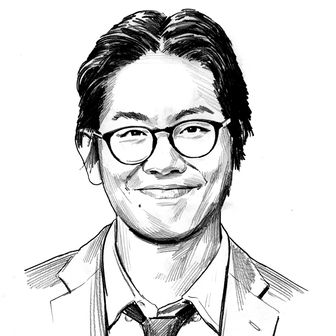
“A High School Assault,” the September 20 episode of the New York Times podcast The Daily, was a quiet, bracing, and emotionally powerful half hour. It was, in part, an adaptation of “I Believe Her,” an essay by Caitlin Flanagan that appeared on The Atlantic’s website on Monday, in which Flanagan tells the story of her own sexual assault in high school back in the 1970s, how she suffered for it, and how, years later, her assailant apologized and she forgave him. Flanagan’s essay was published against the backdrop of Christine Blasey Ford’s accusations of sexual assault against Supreme Court nominee Judge Brett Kavanaugh, which allegedly took place when they were teenagers.
“If Ford’s story is true, Brett Kavanaugh never apologized,” Flanagan wrote in the essay. “He never tried to make amends, never took responsibility for what he did. In my case, the near-rape — as awful as it was at the time and in its immediate aftermath — didn’t cause any lasting damage. But by Ford’s account, Kavanaugh’s acts did cause lasting damage, and he has done nothing at all to try to make that right.”
In The Daily’s telling of Flanagan’s story, listeners are made to go deeper into the broader questions she raises: what it means to have made a mistake in the past, and what it means for the present. In contrast to the essay, The Daily’s version doesn’t strongly evoke the Kavanaugh-Ford story, choosing instead to push more into the universal issues of the story at hand. Vulture spoke with Theo Balcomb, The Daily’s managing producer, about the process of putting the episode together, why they decided to respond to the news cycle with a deeply personal story, and what it takes to produce an evocative daily narrative news podcast.
Step 1: Choosing the Right Story
To understand The Daily’s decision to build an episode around Flanagan’s essay, you have to look at the way the team has been tackling the Brett Kavanaugh assault accusation story, and news cycles more generally. The show had already featured two episodes on the subject this week. On Tuesday, they brought in congressional reporter Sheryl Gay Stolberg to walk audiences through the “tick-tock” — that’s journalism-speak for a piece that unspools a chronological sequence of events — and on Wednesday, they spotlighted White House reporter Peter Baker to provide a measured insight into how various political players would approach Ford’s accusations.
“It was our style of, we’re going to take you through what happened, and hit you with this information, and then you can have your own reactions about the story,” Balcomb said. “But we came in on Wednesday morning thinking, okay, we’ve laid out the facts for people, now let’s have a feeling. We want to hear from a real person who can help us grapple with the story.”
Another producer on the audio team, Andy Mills (who you might remember as the co-host of Caliphate), had sent out Flanagan’s essay in the team’s Slack channel the day before. The essay struck them as exactly the type of story that would help the audience feel through the complexities of the issues. “We were all grabbed by her story, but we had to walk this fine line,” Balcomb said. “We didn’t want to draw too many parallels with the Judge Kavanaugh story, because he’s denied the accusations and because it was important to stay grounded in the facts.”
The choice to pick up Flanagan’s essay was ultimately driven by a sense that the story was much bigger than the Kavanaugh accusations. “We came around to the idea that, in a way, you don’t have to talk about Dr. Blasey and Judge Kavanaugh to talk about this moment,” Balcomb said. “To some extent, the debates we’re having aren’t really about them.” They are, instead, about questions: What does it mean to make a mistake when you were young? What does it mean when the mistake reemerges 30 years later? What does it mean to have been wronged by somebody, to have kept it a secret, and to begin sharing it decades later?
“Of course, what was brilliant about Caitlin’s story is that it gets into all these questions, and it also introduces the idea of forgiveness,” Balcomb said. “How can somebody make it right? How can somebody make it right to the person who they wronged and also in the court of public opinion?”
Step 2: Adapting the Essay
By the time The Daily decided on Flanagan’s essay, it was already widely read across the internet. That informed the way they thought about approaching the episode. “We think a lot about the overlap between what our audience has seen and what’s popular on the Internet,” Balcomb said. “We know we’re going to reach people who aren’t on Twitter all day.”
The team focused on how they could add value to the telling of Flanagan’s story. The essay was structured in a way that felt like a memoir, which gave them a firm thread of building blocks. The impetus rested on figuring out how to go deeper into Flanagan’s experience and flesh out aspects that weren’t as pronounced in the written piece. (In this case, those aspects included the darker elements of the essay, like Flanagan’s suicide attempt.) Similarly, a major factor that defined the episode’s storytelling was the choice to ground the narrative in the gauzy haze of emotional memory around high-school experiences. “I think some of the magic of the piece came from those little high-school moments. It was that time where you’re wanting people so desperately to sign your yearbook, and like, when Caitlin was at a point in her life where she was reading Are You There God? It’s Me, Margaret,” Balcomb said.
“What we’re always trying to do is something in a way that feels natural, but also adds a sense of narrative drama to the proceedings,” she said. “And we don’t want to hit you over the head with something. That’s the trick of The Daily: We’re able to unfold something that holds your attention, feels cinematic, but doesn’t come off like a shtick. We’re not doing this for dramatic effect. We’re doing this to tell you a story.”
Step 3: Producing the Segment
The process began with Annie Brown, a producer on the Times’ audio team who collaborated with Balcomb on the episode, working on an initial script. It was Brown who came up with the idea of using Flanagan’s yearbook as a framing device, which they requested she bring into the studio when she recorded her interview. The script was then passed on to executive Lisa Tobin, who refined the document in pursuit of a stronger narrative structure: how the story would move, when it would turn, how it would shift through time. Balcomb notes that it’s a deeply collaborative process; almost all of it takes place on a living Google Doc where changes, edits, and choices are made in real-time during the flow of production.
Brown and host Michael Barbaro were in Los Angeles for a series of live events slated to take place this week, but in a fortunate turn of events, Flanagan also happened to be in the city at the same time, which meant they could record the interview in-person. Balcomb noted that the team would have typically conducted the interview remotely, and that she believed the segment would have turned out to be effective that way. Nevertheless, she argued that part of the distinct power of the episode lay in the fact that you can very clearly hear that Barbaro and Flanagan were in the same space together. “It was a happy accident,” she said.
When Barbaro conducts an interview, he tries to create an intimate emotional space for the guest, but he does this while actively monitoring the script, which continues to evolve as the production listens in, makes adjustments, and changes directions based on what’s happening.
One of the core challenges the team faced producing this episode lay in the fact that Flanagan had to relive a deeply personal trauma in front of a microphone. A baseline familiarity with the show, and Barbaro as a host, helped tremendously. “We had an advantage — and I don’t think Caitlin will mind me saying — is that she’s a huge fan of the show,” Balcomb said. “I think she already felt pretty comfortable with Michael because she’s listened to him every day and knows the lengths the show goes to embrace nuance and to give people ample time to share who they are.”
Nevertheless, it was an incredibly sensitive scenario. “You can hear in the interview that she felt surprised about how emotional she got,” Balcomb said, adding, “I think Michael’s really good at listening and just being quiet — that’s something that we, as audio producers, know pretty well, and have worked with him from the beginning on. You need to fill the space and let people be.”
Step 4: Editing, Refining, Listening
After completing the recording process, the team divides up the work. The Daily is currently made by around 12 producers, and typically two or three producers work on an episode at the same time; in this case, Brown produced the beginning and Balcomb produced the end. They began by creating a live log of the interview, which they then collectively reviewed for pieces to be used and talk through how things fit together. A lot of this involves the hard work of omission — “There were so many beautiful, heart-wrenching stories, but we knew we could only have one,” Balcomb said — and a lot of it involves feeling out a sense of balance. How much do they want to discuss Kavanaugh and Ford in the context of the story? Do they want to talk about that at all?
Once the story pieces are selected, the process shifted towards the meat-and-potatoes of audio production: cutting tape with Pro Tools, deciding where everything gets put together, and so on. “It wasn’t a very difficult story to edit,” Balcomb said. “But, of course, the hardest part was making sure the segment felt like it had the right length, and that it retained many of the little gems that we remembered loving from the interview.”
The episode was then collaboratively reviewed and edited multiple times. A slight touch of scoring was added — “I didn’t think it needed a heavy hand,” Balcolb said — and a final listen was conducted before the audio file was handed to the team’s engineer in London, who then published the episode in the early morning, Eastern Standard Time.
The team is particularly proud of the end product. “Just the idea that we’ve made a thing where this kind of rumination can live makes me so proud of the show,” Balcomb said. “We’re able to bring this woman’s experience to millions of people, and I should say, the reaction has been overwhelming. There were so many people who wrote saying, Thank you for being brave enough to share this, and, you know, I’m reconsidering some of the experiences I’ve had and how I can make them right or how I can talk to people about them. I’m thrilled about it.”
You can listen to the episode here.





